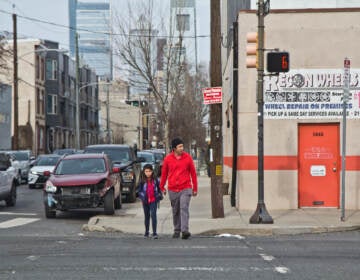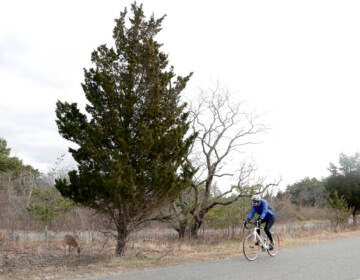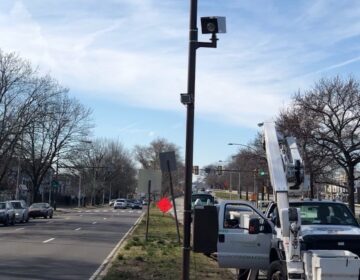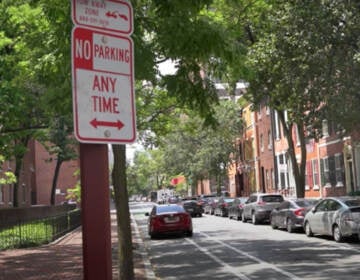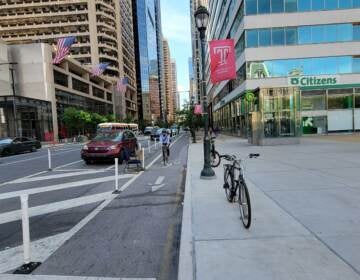Philly pushes Harrisburg to pass law allowing safer bike lanes on state roads
The city wants to build more bike lanes that protect cyclists from getting “doored.” Officials say state law stands in the way on some major Philly streets.
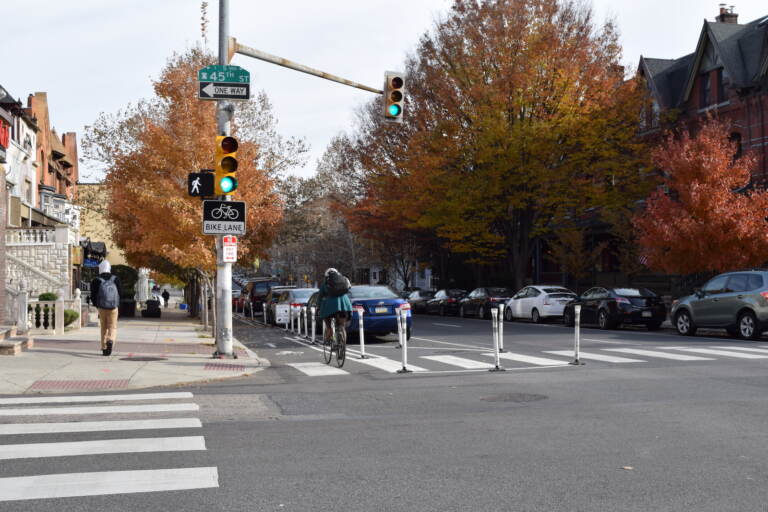
A parking-separated bike lane on Chestnut Street (Courtesy of OTIS)
Results are in from a study of parking-separated bike lanes in Philadelphia: they slow cars down, attract more bikes, and reduce deadly crashes. Now it’s up to the state legislature to pave the way for Philly to create more.
“The city has been looking to install more protected bike lanes throughout the city as a really sustainable, safe mode of transportation that’s accessible and affordable,” said Kelley Yemen, Philadelphia’s director of Complete Streets. “We are waiting anxiously for the passage of H.B. 140, which would allow us to install these more regularly on all state routes.”
Parking-separated bike lanes are what they sound like: bike lanes placed on the outside of on-street parking, rather than on the inside, so that the line of parked cars protects cyclists from vehicle traffic.
“Instead of having next-to-the-curb parking, and then a bike lane, we switch them,” Yemen said. “It provides separated space away from all the moving cars for bicyclists to operate safely.”
There are currently around 20 miles of protected bike lanes in the city, including parking-separated bike lanes, Yemen said. But state law makes it difficult for the city to install these bike lanes on state routes that are maintained by PennDOT — which are often where they’re needed most.
“They’re usually streets where everybody kind of wants to be there,” Yemen said. “That’s the commercial street. It’s the main connector that might actually go over bridges or rail yards … so it provides that key connectivity as well as access to all sorts of destinations. But because the traffic volumes are higher, we really need something safer and more separated on them.”
In a pilot project launched in 2018, city and PennDOT officials installed parking-separated bike lanes on 10 state routes in the city, including Market Street, JFK Boulevard, Race Street in Center City, and the Chestnut Street Bridge. They’ve also evaluated case studies in peer cities, which showed parking-separated bike lanes increase perceived safety and comfort for cyclists, according to a report written by transportation consultant Kittelson & Associates, Inc.
The results of the Philly pilot — released for the first time this month — are encouraging.
Officials collected data on five-block sections of JFK Boulevard and Market Street where parking-separated bike lanes were installed, and compared it to data from those same streets before the special bike lanes were installed, in 2012 to 2016.
They found crashes decreased by nearly 20% (although fewer people driving during the pandemic may have contributed). Car speeds went down 6%, but the city did not see evidence of more congestion. Transit speeds slowed down only slightly. And the most encouraging conclusion may have been the number of bikes using the roads, which increased 96%.
The city plans to keep collecting information, particularly on safe intersection designs and the best materials for the barriers between lanes. But Yemen sees the early data as proof that parking-separated bike lanes work in Philly.
“[The lanes are] providing that more welcoming space for more types of cyclists,” Yemen said. “It provides them that security that they’re not going to be sideswiped or hit, which can be some of the most fatal bicyclist crashes.”
Reducing the risk of getting ‘doored’
Joe Cox often takes up a travel lane when he bikes through the city on his delivery routes, because he’s terrified of getting “doored” — or thrown off his bike when the driver of a parked car opens their door — while he’s riding in a traditional bike lane.
“One of my top fears is a door flying out,” he said. “They didn’t look.”
A bike safety advocate and former City Council candidate who spreads free pizza and a “positive mental attitude,” Cox also works as a bike courier for a company that picks up DoorDash, Grubhub, and Uber Eats. That means he bikes in all weather and on a variety of streets.
He rides on the city’s parking-separated bike lanes often, and said sometimes, he still sees cars parked in the bike lanes.
“But for the most part, it’s much safer than what it was — like, a lot safer,” he said.
Cox recently tried out the parking-separated bike lane on the reopened Chestnut Street Bridge, and posted a video of his ride to TikTok.
“That dumb*ss car with the door can’t hit me,” he can be heard saying, as he bikes past a parked car with its doors open, with plenty of room to spare. “Yes. Yes. Whaaaat!”
The parking-separated bike lanes the city piloted include a buffer of several feet between the parking lane and bike lane, marked with flexible white posts. By keeping cyclists away from moving traffic, parking-separated bike lanes prevent cyclists from getting run over by a car if they do get doored. And the buffer space is good for drivers too, who need space to load bags or kids into cars.
“That buffer serves a dual purpose for both bicyclists and drivers,” Yemen said.
To Cox, parking-separated bike lanes are important for getting more people on bikes.
“I would imagine somebody that doesn’t bike as much … would feel much safer with those lanes than others,” he said. “And those are the people that we really need to be fighting for.”
State legislation is needed for more parking-separated bike lanes
Historically, parking-separated bike lanes have been limited on state roads in Philadelphia, as state law requires parking to be located within a foot of the curb. But a bill currently before the Pennsylvania state legislature would change this, allowing cars to park within a foot of the buffer of a parking-separated bike lane.
House Bill 140 passed the Pennsylvania House unanimously last year. The Senate Transportation Committee heard testimony on the bill last week, but it’s unclear when it might come to a vote before the Senate.
House Bill 140 is state lawmakers’ third attempt at allowing parking-separated bike lanes, according to the Bicycle Coalition of Greater Philadelphia, which supports the effort. A similar bill got stuck in a Senate committee in 2017, and another met the same fate in 2019. Cox said he rode his bike from Philadelphia to Harrisburg to voice his support for one of these bills, with the names of cyclists who have died in crashes on his bike trailer.
Without the bill becoming law, parking-separated bike lanes planned for Lehigh Avenue and Chestnut Street are in jeopardy, Yemen said.
“If the legislation is not passed, I don’t know what the fate of protected bike lanes will be on state routes,” she said.
WHYY is your source for fact-based, in-depth journalism and information. As a nonprofit organization, we rely on financial support from readers like you. Please give today.




